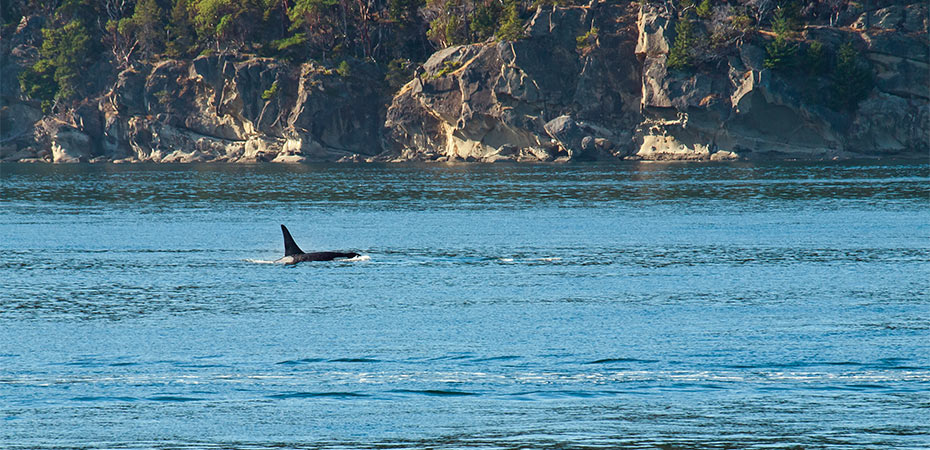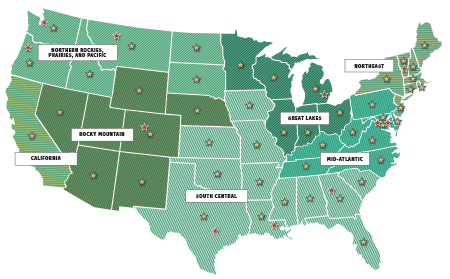Floodplains are some of the most valuable ecosystems on Earth. Typically located next to rivers, streams, and coasts, they are nature's best defense against destructive floods. Floodplains provide essential habitat for wildlife, improve water quality, and protect human communities.
However floodplains are often considered prime building locations. Development along river corridors has significantly altered floodplain functions, leading to more frequent and severe floods, extensive loss of fish and wildlife habitat, and greater risk to water supplies. Floodplains rarely receive the protection they deserve—instead federal flood insurance policies actually encourage development of these key habitats.
As climate change leads to larger and more severe storms, rivers will need more room to flow. Protecting and restoring floodplains is essential if we hope to protect public safety, maintain water quality, and restore imperiled fish and wildlife.

How floodplains are developed is largely determined by FEMA's National Flood Insurance Program. Although FEMA's insurance program is supposed to guide development away from flood hazard areas, the program actually encourages and subsidizes dangerous floodplain development. The National Wildlife Federation is working to strengthen floodplain protections at the local, state, and federal levels to stop allowing harmful new development in critical flood hazard areas.
Through successful legal actions, the National Wildlife Federation is forcing FEMA to protect endangered species while it provides flood insurance through the National Flood Insurance Program.
Orca and Salmon in Puget Sound: In 2004 a federal district court in Seattle agreed with the National Wildlife Federation and found that FEMA's flood insurance program encouraged floodplain development and harmed salmon already threatened with extinction. He ordered FEMA to consult with the National Marine Fisheries Service (NMFS) to ensure compliance with the Endangered Species Act. NMFS issued a biological opinion in September 2008 finding that the National Flood Insurance Program is pushing orca and several runs of salmon towards extinction, in violation of the Endangered Species Act. As a result, FEMA must now include habitat protections in its floodplain management requirements, which will help reduce risks to fish, wildlife, and people.
Salmon and Steelhead in Oregon: The National Wildlife Federation and others filed a similar case against FEMA for issuing flood insurance throughout Oregon without consulting with the expert agency over impacts to threatened and endangered salmon and steelhead. FEMA is now consulting with NMFS and promises to include salmon habitat protections soon.
Sea Turtles in Florida: In July 2010 the National Wildlife Federation initiated a lawsuit under the Endangered Species Act against FEMA for issuing flood insurance throughout Florida without consulting with the expert agency over impacts to endangered sea turtles. In January of 2011, the National Wildlife Federation reached a settlement with FEMA where FEMA agreed to initiate consultation proceedings with the U.S. Fish & Wildlife Service and NMFS to ensure that sea turtles are protected from the impacts of floodplain development induced by FEMA.
Key Deer in Florida: Culminating years of litigation and several important legal victories, in 2010 the National Wildlife Federation settled a lawsuit that ensures that measures are in place to protect eight threatened and endangered species, including the endangered key deer, from the harmful impacts of floodplain development spurred by FEMA and the National Flood Insurance Program. The two-foot-tall Key deer is an endangered species that lives in a very small region of the Florida Keys. The U.S. Fish & Wildlife Service found that federal flood insurance issued by FEMA was encouraging development and jeopardizing their habitat.
Endangered Species in Missouri: The National Wildlife Federation sent FEMA a 60-day notice of intent to sue for issuing flood insurance throughout Missouri without consulting with the expert agency over impacts to the interior least tern and pallid sturgeon.
While preventing harmful development in floodplains is essential, it will not do enough to establish health floodplains. To recover imperiled fish and wildlife and protect communities from flooding, we also have to fix the many problems that have resulted from more than a hundred years of development, dikes, levees, and dams.
The National Wildlife Federation is working to solve complex floodplain management problems by collaborating with federal, state, and local governments to fix past mistakes and harmful policies. These solutions build on knowledge gained from our collective experience in floodplain management and ecosystem restoration.
Floodplains throughout the United States have been leveed, diked, and built upon. Increasingly severe storms and budget-busting flood damage suggest that it’s time to reconsider the value of floodplains and begin restoring their natural ability to protect communities from flooding and provide habitat for fish and wildlife.
Key strategies to restore floodplains include:
Thousands of properties have been flooded multiple times and rebuilt at taxpayer expense. To prevent additional damage and expense, and to improve the ability of floodplains to accommodate floodwaters, many of these properties should be removed.
Buyouts involve the voluntary sale, at fair market value, of flood-prone structures. They provide a permanent solution to the risks and damages of repetitive flooding.
Buyouts significantly reduce public costs and they get people out of harm’s way. Buyouts also provide the added benefits of improved flood storage and conveyance and open space for wildlife refuges and fisheries habitat.
For more information on buyouts, visit the King County Flood Buyout and Home Elevation Program.
Although levees are frequently built for flood protection, many are located close to the river and are not able to hold increasingly larger floods. They often create a false sense of safety for those behind them and they cut off access to important floodplain habitat.
Often levees only reduce flood damages for ordinary events; in extreme events these structures commonly fail, causing more catastrophic destruction than if the structure had not been there at all.
In many places, moving levees further from the river creates multiple benefits. It reconnects the floodplain to the natural river system, increases the river’s ability to absorb more stormwater, reduces risk of flooding and flood damage, and restores valuable riparian habitat for fish and wildlife.
Learn more about our work to prevent the New Madrid Floodway project from endangering wildlife and wetlands habitat in Missouri.
Development along river corridors has significantly altered floodplain function and led to extensive losses of wetlands and fish and wildlife habitat. Floodplain restoration can effectively turn damaged areas into productive habitat. Habitat restoration can provide multiple benefits including:
Restoration must incorporate the best available science and projected impacts of climate change to avoid further flood risk to people and property. A variety of state and local conservation plans, including salmon restoration plans, the State Wildlife Action Plan, and others can help guide restoration efforts for priority habitat areas.
Green Infrastructure is a set of tools and approaches that integrates conservation goals with development, growth, and infrastructure planning. It uses natural processes to absorb stormwater rather than funneling stormwater directly to streams.
Green Infrastructure can help reduce or delay stormwater runoff volumes, enhance groundwater recharge, and reduce stormwater pollution. It can also help increase carbon sequestration, reduce energy demands, and increase wildlife habitat.
Tools and approaches associated with Green Infrastructure include:
Take the Clean Earth Challenge and help make the planet a happier, healthier place.
Learn MoreA groundbreaking bipartisan bill aims to address the looming wildlife crisis before it's too late, while creating sorely needed jobs.
Read MoreMore than one-third of U.S. fish and wildlife species are at risk of extinction in the coming decades. We're on the ground in seven regions across the country, collaborating with 52 state and territory affiliates to reverse the crisis and ensure wildlife thrive.
